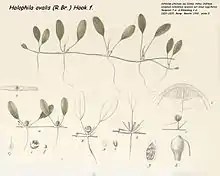| Halophila ovalis | |
|---|---|
 | |
| Scientific classification | |
| Kingdom: | Plantae |
| Clade: | Tracheophytes |
| Clade: | Angiosperms |
| Clade: | Monocots |
| Order: | Alismatales |
| Family: | Hydrocharitaceae |
| Genus: | Halophila |
| Species: | H. ovalis |
| Binomial name | |
| Halophila ovalis | |
| Synonyms | |
|
Halophila ovata | |
Halophila ovalis, commonly known as paddle weed, spoon grass or dugong grass, is a seagrass in the family Hydrocharitaceae. It is a small herbaceous plant that naturally occurs in sea beds and other saltwater environments in the Indo-Pacific. It was introduced as isolated populations in Florida, Cuba and Antigua.[2]
The first description of the species was by Robert Brown as Caulinia ovalis, this was transferred to the genus Halophila by Joseph Dalton Hooker in Flora Tasmaniae (1858). The species name Halophila ovata is now regarded as a synonym of this species.[3]
The plant occurs around reefs, estuaries, islands, inter-tidal areas, on soft sand or mud substrates. The leaves are ovate in outline, appearing on stems that emerge from rhizome beneath the sand. The roots get up to 800 mm long and covered in fine root hairs. It is often found in meadows that dominate a sand bank or other patch of sea floor. The arrangement of the plant, above and below ground, provides stability to the sea floor and habitat for other species. It is used as food by dugong, as is therefore known as dugong grass.
References
- ↑ Short, F.T., Carruthers, T.J.R., Waycott, M., Kendrick, G.A., Fourqurean, J.W., Callabine, A., Kenworthy, W.J. & Dennison, W.C. (2010). "Halophila ovalis". IUCN Red List of Threatened Species. 2010: e.T169015A6561794. doi:10.2305/IUCN.UK.2010-3.RLTS.T169015A6561794.en. Retrieved 18 January 2024.
{{cite journal}}: CS1 maint: multiple names: authors list (link) - ↑ "Halophila ovalis". invasions.si.edu. Retrieved 30 October 2023.
- ↑ "Halophila ovata". FloraBase. Western Australian Government Department of Biodiversity, Conservation and Attractions.Name Currency Archived 2011-05-24 at the Wayback Machine
External links
- "Halophila ovalis". FloraBase. Western Australian Government Department of Biodiversity, Conservation and Attractions.
